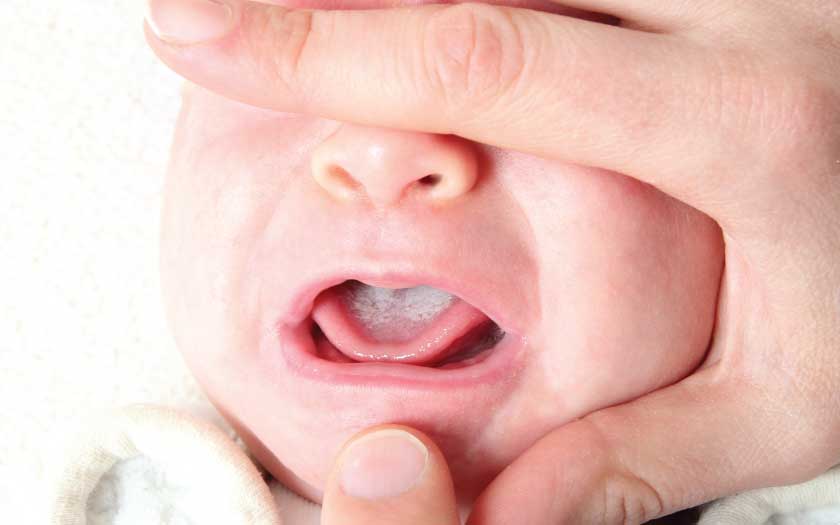Ever wondered about the slightly unsightly white spots seen on your baby’s tongue whenever the little one yawns or cries? It’s probably oral thrush, a harmless and common thing in babies during their infancy. Problems may occur though when a baby’s oral thrush is passed to the mother’s breast through nursing.
Oral thrush is a fungal infection that occurs in a baby’s mouth. Although it is considered an infection, it is quite harmless to a baby’s health. It is mainly seen in newborns, but it may also be found in toddlers right up to the age of two years.
Oral thrush is caused by a strain of yeast fungus called ‘Candida albicans‘, which lives on the skin, in the bowel, and inside the human mouth. Although usually harmless, it can sometimes cause an infection when too much of it grows and becomes a thrush. Newborn babies, whose immune systems are still developing, are more vulnerable to a thrush infection.
Oral thrush may appear in around one out of twenty babies. It is most common in babies up to four weeks old, although older babies can get it too. Premature babies (babies born before 37 weeks) have an increased risk of developing oral thrush.
It’s quite easy to recognise oral thrush — they look like white spots or patches in and around the baby’s mouth and tongue. These patches may be white or resemble cream-colored curd. You’ll find them on your baby’s gums; tongue; roof of the mouth (palate) and even inside of the cheeks. When joined together, the patches of thrush from what’s called plaques.
Other signs and symptoms of oral thrush in babies include:
- Saliva that looks whitish
- Baby seems hungry but is unable to nurse comfortably
- A clicking sound is heard during feeding
- Baby seems to dribble more than usual
Oral thrush is not very easy to clean off a baby’s mouth for they do not rub off easily. The tissue underneath the thrush may also appear red and raw. Although they may not bother a baby much, if they become sore, a baby may become fussy and refuse to feed.
Treating thrush in a baby
Most cases of oral thrush clear up without the need for any kind of treatment other than gentle cleansing with a clean, soft, and wet handkerchief. In particularly troublesome cases, a visit to the doctor will be needed. You may be given antifungal gels or drops for treating the baby’s oral thrush. Note: Always speak to your doctor before using over the counter products as some gels are not suitable for very young babies.
Remember, in the case of oral thrush, if the baby is breastfeeding, the mother’s nipples may need to be treated at the same time as the baby to prevent the infection from being passed back and forth.
Can oral thrush in babies be prevented?
Most people, including babies, have Candida in and on our bodies, hence we can’t possibly prevent thrush from occurring. We can, however, prevent it from flourishing and becoming infected. Here are some steps to take:
- If your baby is bottle-fed, sterilise the bottles and other feeding equipment regularly, especially the bottle nipples.
- If your baby uses a pacifier, ensure that it is cleaned properly before giving it to him. The same should be practiced with toys that are meant for baby to bite, such as a teething ring.
- Offer baby a few sips of water after each feed to help wash away and milk residues left in his mouth.
Nipple thrush in nursing moms
You may be having nipple thrush infection if you feel shooting pain in your nipples while you’re feeding your baby, which may continue after the feed is finished; burning or itching sensations in one or both of your breasts; if your nipples are becoming cracked, flaky or feel extremely sensitive; or if you notice that the areola is red or shiny.
Symptoms of nipple thrush do not include fever or redness of your breasts. A nipple thrush infection is difficult to diagnose because you may have no symptoms, even if it is confirmed that your baby has oral thrush. To complicate things further, the symptoms you do have may also be found in other conditions. For example, pain in your nipples could also be caused by a bacterial infection.
Treating nipple thrush
If you do have symptoms, or if the infection is causing problems with feeding, your doctor may prescribe an antifungal cream. If your infection is more severe, your doctor may recommend a course of antifungal tablets. If your doctor prescribes antifungal cream or tablets for you, your baby will probably be treated at the same time, to prevent re-infection. You should visit your doctor again if the infection does not clear up after a few days, or if feeding problems continue.
If you have no symptoms, you’re unlikely to need treatment, even if it’s confirmed that your baby has oral thrush. However, your nipples may need to be treated at the same time as the baby to prevent the infection from passing back and forth.
Featured image source: Shutterstock


